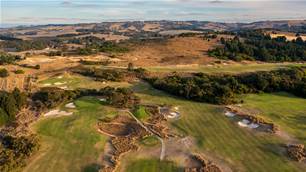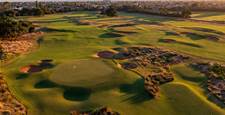The ranking of Australia’s Top-100 Courses for 2024 was recently published in Golf Australia Magazine.
 Obviously, some courses – boasting genuine claims to be included among the centurions – had to miss out.
Obviously, some courses – boasting genuine claims to be included among the centurions – had to miss out.
Here are the courses, 40 of them actually, that narrowly missed selection in the 2024 Top-100 ranking but are superb layouts in their own right and will certainly be among the contenders for inclusion looking ahead to our ranking to be published in 2026.
101. JOONDALUP RESORT – Dune/Lake Course
Connolly, Western Australia
Designer: Robert Trent Jones Jnr (1985)
The last of the three course configurations at Joondalup bypasses the excellent Quarry nine but it does take in two pretty impressive loops of nine holes. The Dune Course’s dramatic elevation changes flows seamless into the less penal lunar landscape of the Lake nine.
As is the case across the entire 27 holes, the conditioning is nothing short of five-star and is another reason why Joondalup (pictured above) is a ‘must play’ for any golfer visiting Perth.
102. KEYSBOROUGH GC
Keysborough, Victoria
Designer: Sam Berriman (1946)
Having formed in 1899, the Keysborough club moved to its current site in 1946 when Sam Berriman – who oversaw construction of fellow Sandbelt course, Huntingdale – was commissioned to create a layout for the club. His course covered open, grazing land but today’s course is tree-lined with five lakes coming into play.
The routing at Keysborough is very good and there is no mistaking the Sandbelt-style bunkering, large smooth putting surfaces and excellent couch fairways.
Keysborough’s one-shot holes are a standout, with arguably the best of them being the par-3 12th. The hole lays alongside a lake with a number of lakeside tees changing the angle of approach to the green. The angled green, with three bunkers left and one to the right, is a tough one to hit and pars here are well-earned.

103. ALBANY GC
Albany, Western Australia
Designer: Unknown (1899).
One of Australia’s oldest courses remaining on its original site, Albany’s popularity has seen a resurgence in recent years. And for good reason.
Dominated by holes that cover beautiful rolling sand dunes and are the basis for some of the most natural links holes in the country, Albany is a fun course for all golfers.
This is not a particularly long course, which suits the high handicapper, while better players can enjoy the challenge of playing a variety of shots from a host of different lies during a round.
And if your golf is no good on the day, enjoy the walk and the views across King George’s Sound.
104. ROSEBUD CC – South Course
Rosebud, Victoria
Designers: Jack Watson (1964); Geoff Ogilvy, Mike Cocking Ashley Mead – OCM (2018 & ongoing).
Rosebud has undergone a resurgence in recent years, much of which can be attributed to the implementation of the OCM redesign masterplan as well as work of course superintendent Ian Todd and his green staff.
While the neighbouring North Course has captured most of the accolades – courtesy of the wonderful land it lies across– the South Course is slowly gaining greater recognition as a well-designed, well-presented layout to play.
105. PACIFIC DUNES
Medowie, New South Wales
Designers: James Wilcher (2005).
If you are looking for variety in one round of golf, Pacific Dunes fits the bill.
The front nine is tight and bordered by thick trees or bush on both sides of most holes whereas the back nine is much more open with water in play for almost every full shot. This striking variation characterises Pacific Dunes and gives it a definite allure, which is important for a site with almost no elevation change.

106. PACIFIC HARBOUR G&CC
Banksia Beach, Queensland
Designer: Ross Watson (2006).
The conundrum of every course designer – you need to challenge better golfers, while not alienating the bulk of golfers from casual to mid- and high-handicap players.
It is a fine line but experienced architects like Watson have proven it can certainly be done, as you will find at Pacific Harbour – a fine island links course where golfers of all standards can play fun golf and not feel bashed up by the time they’ve reached the 18th tee.
107. TWIN WATERS GC
Twin Waters, Queensland
Designers: Peter Thomson, Mike Wolveridge & Ross Perrett (1991).
Built during the resort course construction boom of the late 1980s, Twin Waters was an instant success on Queensland’s Sunshine Coast.
This is where links design and topography meet a tropical climate in a popular and playable melange of styles from opposite sides of the globe.
Each hole occupies a wide corridor of gently rolling terrain, but Thomson’s many pot bunkers have an infuriating way of narrowing the playing lines on several holes, while the green complexes offer a generous slice of challenging links golf.

108. THE COAST GC
Little Bay, New South Wales
Designers: Members and Jim Ferrier (late 1920s/early 1930s); Members (1973); James Wilcher (2007).
The Coast lies across some of the best golfing land in New South Wales, with the highly- ranked St. Michael’s and New South Wales Golf Clubs to the south, and the quirky Randwick Golf Club to the north.
The layout has rarely looked better and, as to be expected of a seaside course, the course is set up perfectly – the ground is firm and an absolute pleasure to pinch irons and wedges from, while the greens surrounds, too, are more receptive to a greater variety of approach shots to the putting surfaces.
109. RACV ROYAL PINES RESORT – Green/Gold Course
Ashmore, Queensland.
Designers: Tomojiro Maruyama (1990); Graham Marsh (2015).
What was previously a course characterised by large, flat and relatively open greens – with bunkers to match – was transformed nearly a decade ago by Graham Marsh.
It elevated what was a straightforward and largely uninteresting layout into a resort course that was far more intriguing and requiring thought during play.
Marsh always felt the old design benefited long hitters way too much and his redesign was based on giving more scope to players with less length to show off their skills.
The site is still relatively flat, but the green complexes are now far more dramatic.
110. SANCTUARY COVE G&CC – Palm Course
Sanctuary Cove, Queensland
Designers: Fred Bolton (1988); Ross Watson (2011).
Ross Watson’s complete rebuild of the popular Palms Course extracted the best possible golf holes from the land, while working within the confines of the surrounding residential community and the numerous lakes and water hazards that cover the property.
The result was a fantastic addition to the golf rich Gold Coast landscape.
The Palms is relatively short for a modern layout. However, that does not make it any less challenging, but golfers may find it more fun as the demands here are more about accuracy and strategy rather than strength and length.
111. THE FURROWS – Kingston Heath
Heatherton, Victoria
Designers: Geoff Ogilvy, Mike Cocking Ashley Mead – OCM (2023).
The Furrows only opened for play in April 2023, and it immediately captured the hearts and minds of every golfer who has been lucky to play the nine-hole par-3 course at Kingston Heath.
OCM transformed land from flat market gardens (and sometimes media parking during tournaments) into dramatic Sandbelt holes – ranging from 50- to 140-metres – which have been inspired by the approach shots you face on the adjoining Kingston Heath championship layout, as well as classic courses found elsewhere in the world.
This layout is as enjoyable and challenging for beginners and casual players as it is for scratch markers and professionals.

112. HORSHAM GC
Horsham, Victoria
Designers: Sam Berriman (1946); Neil Crafter & Paul Mogford – Golf Strategies (2010 and ongoing).
No course in this country has undergone as much unplanned, dramatic change in the past 15 years.
But the bounce back after the devastating Black Saturday bushfires tore through Horsham in 2009 has been enormous. More than 90 percent (about 15,000) of the mature trees on the course were destroyed and as a result what was a narrow, tree-lined layout has now become sparser.
While the Berriman created course had won much acclaim over the years, the current layout, based on a masterplan prepared by course designers Neil Crafter and Paul Mogford, is a more interesting and strategic course for players of all standards.
The sand base is one of the key aspects that has been incorporated into the redesign with ‘new’ bunkers being a feature.

113. YARRAWONGA MULWALA GC – Murray Course
Mulwala, New South Wales
Designers: Sam Berriman (1957); Peter Thomson & Mike Wolveridge (1982 & 1986).
It says a lot about the high quality of golf courses to be found across this country when one of the best courses to be found on the length of the great Murray River narrowly misses a spot in the Top-100 ranking.
The Murray Course, with its huge river gums and natural lagoons bordering many of the fairways, is an acclaimed layout both in terms of design and presentation and offers great value for money golf for the travelling golfer.
More than 75 percent of the course was inundated by floodwater early in 2023, with water levels surpassing record heights set back in 1993. But within a few months, the layout was back to being ‘pure’ except for a few missing trees that had been damaged by water.
Related Articles

Drinks With... Ricky Ponting

International Spotlight: Omanu Golf Club








_15th_hole.jpg&h=115&w=225&c=1&s=1)




